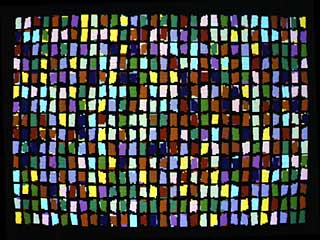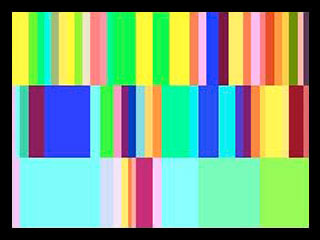1986
ISOMORFISMI SUONO LUCE – RITRATTO
Digital animation
2 min. 49 sec.
Stereo
Color
1986
![]()
ISOMORFISMI SUONO LUCE is a series of works presented at the Venice Biennale. In this animation real world images, digitized with a camera, are processed and edited along with abstract synthetic sequences. The music is made up of synthetic and recorded sounds.
![]()
![]()

ISOMORFISMI SUONO LUCE – STUDIO 3
Digital animation
1 min.
Mono
Color
1986
![]()
In this animation the whole screen is colored. As in STUDIO 1 and STUDIO 2, pitches are mapped onto hues, and brightness onto loudness.
The music of STUDIO 3 is a random sequence of sounds.
![]()
![]()

ISOMORFISMI SUONO LUCE – STUDIO 2
Digital animation
42 sec.
Mono
Color
1986
![]()
In this animation, which follows STUDIO 1, each colored rectangle corresponds to a note of the musical scale, and is shown only when its note is played, creating a sort of colored scale. This is a variation over the theories of the Italian painter Luigi Veronesi. The two musical voices are only heard, while the third voice is only visualized. Rectangles’ hues are established by sound pitches, while luminosity represents loudness.
The music of STUDIO 2is also the visual representation of Canon Perpetuus super Thema Regium, BWV 1079 from The Musical Offering, by J. S. Bach.
![]()
ISOMORFISMI SUONO LUCE – STUDIO 1
Digital animation
1 min. 48 sec.
Mono
Color
1986
![]()
In this animation each coloured rectangle corresponds to a note, following the theories of the Italian painter Luigi Veronesi, who had made several paintings based on the music of various composers, including Johann Sebastian Bach.
Every horizontal stripe of the animation represents a musical voice. Rectangles’ width is set by notes’ length, while sound pitches control rectangles’ hues, and brightness is related to loudness. Rectangles appear on the right side of the screen in synch with the tones.
STUDIO 1 is the visual representation of the Canon Perpetuus super Thema Regium from Musikalische Opfer, BWV 1079, by J. S. Bach, accompanying the animation. It should be noted that this section of Musikalische Opfer was not composed for a specific instrument, and this, coupled with the fact that it is a perpetual canon, makes it ideal for a digital version.

